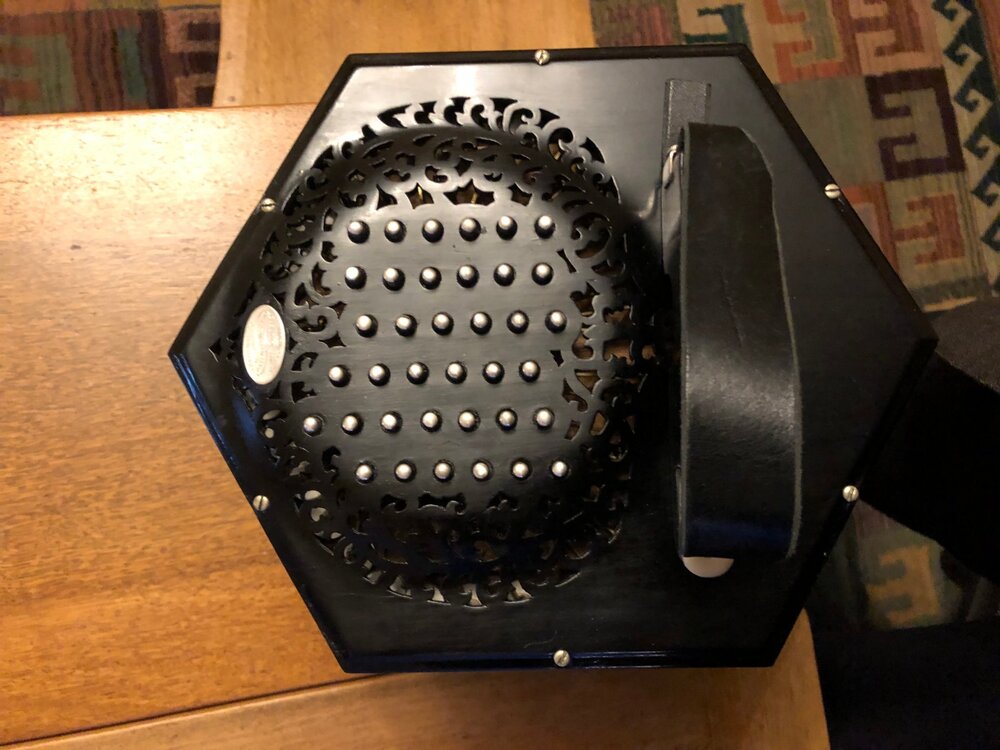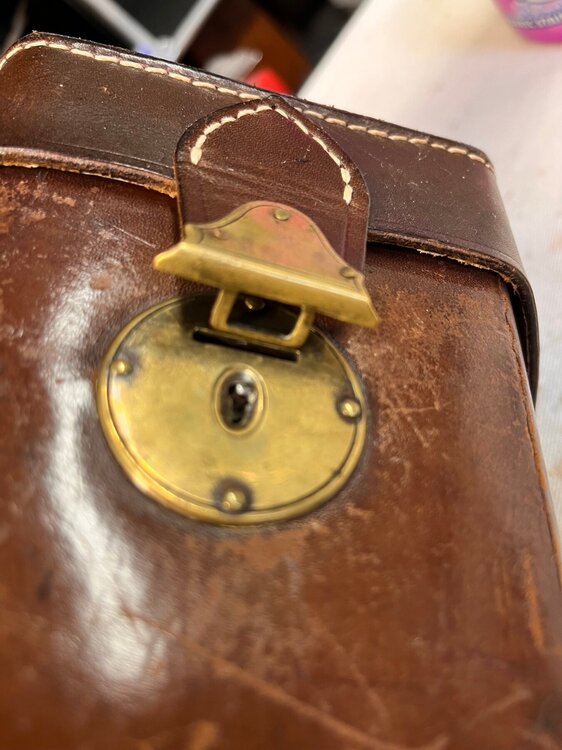
Alex West
Members-
Posts
554 -
Joined
-
Last visited
Everything posted by Alex West
-
WTB a fixer upper/poor condition anglo concertina
Alex West replied to Surly Boy's topic in Buy & Sell
LR71 The vendor sent me some additional pictures which - to my eyes at least - confirm that the base instrument is a Lachenal with their typical gate and lever action rather than a riveted lever. The stamp on the fretted ends looks like the C Jeffries font, but the ends themselves aren't as finely detailed as you'd expect from a C Jeffries. Restored, it might be worth what a typical 30 key Lachenal would be, but the vendor didn't tell me (or didn't know) what keys the instrument is in Alex West -
PM sent Alex West
-
Looks like a 46 key Maccann duet Alex West
-
[COMPLETE] Wanted: 57 Key Maccann Duet Concertina
Alex West replied to McCarthy's topic in Buy & Sell
McCarthy, I have a 62 key Lachenal New Model Maccann which I'm looking to move on as I'm principally an anglo player. It's been fully restored and I can send you some more information and pictures if you're interested. I'm looking for around £2,000 plus postage/courier Alex West -
Yes Marien, I meant Titebond Original which is an aliphatic resin Alex West
-
If I'm removing old chamois to replace with new, I always clean off any old glue so that I'm glueing directly to wood. In some cases, this has meant re-fixing the triangular reed-pan support blocks so that the height matches. I've never had a problem cleaning up either the PVA or Titebond (which sets brittle and can chip off easily) but I'll happily give fish glue a try. I like animal glues in general, but I'll give Gorilla glue a miss... Alex West
-
I mostly play English/Scottish tunes with occasional forays into Swedish and Quebecois. I mostly play a G/D box, but yes, I use the thumb like a normal button as an addition to chords. I rarely (well, never) use it as a drone - though I can see if you're playing Irish style concertina you might find the D (or even a G?) useful Alex West
-
I usually use either a woodworking PVA or Titebond. You don't need much and both work OK Alex West
-
Paul Read. Nice bloke, on this forum and good for this job I'm not sure why you're in such a rush to make this change though. On a typical 38 key Jeffries, you have D in both directions, but the C/F thumb button gives you a C on the draw and an F on the push which you otherwise don't have at that pitch Alex West
-
Helpful (I hope!) learning strategy
Alex West replied to paaudio's topic in General Concertina Discussion
Musescore now comes bundled with Audacity as "MuseHub". https://musescore.org/en. Audacity does all the things that the OP does to change pitch, change tempo, edit and adjust audio files. MuseHub is free. Alex West -
WTB - Crane or Jones Anglo w/Brass Reeds
Alex West replied to saguaro_squeezer's topic in Buy & Sell
Jacques I just re-sent it to the address you sent me in a PM Alex West -
Button diameter thoughts for Anglo
Alex West replied to Jason's topic in General Concertina Discussion
Jason I don't know the specific button diameters of the Clover and the Morse, but I've measured button diameters between 4.1mm (metal) from a vintage Jeffries to 7.9mm (bone) for a vintage Lachenal. The 4.1mm buttons can feel needle-like and quite painful until you get used to them, but they do allow for very precise playing. The large buttons are easier to hit but can feel a little clumsy and difficult to move from one button to the next. I tend to prefer the smaller diameter buttons around 4.5mm - 5mm diameter with a small amount of rounding to the edges but others will, I'm sure, have different opinions. Once you compare one button with another, it's possible to get bothered by whether they're flat topped with very straight edges, have very rounded edges or in the extreme are very domed (like some of the "metal over a wooden core" button typical of a Wheatstone). It's possible to get used to any button in my experience. It also depends on how the instrument is set up and whether there's a long travel or whether they sit flush or proud of the fretboard when depressed. Alex West -
WTB - Crane or Jones Anglo w/Brass Reeds
Alex West replied to saguaro_squeezer's topic in Buy & Sell
Email sent Alex West -
WTB - Crane or Jones Anglo w/Brass Reeds
Alex West replied to saguaro_squeezer's topic in Buy & Sell
I have loads of pictures! If you want to let me know your email address, I can send you them either via Dropbox or similar. Alex West -
WTB - Crane or Jones Anglo w/Brass Reeds
Alex West replied to saguaro_squeezer's topic in Buy & Sell
Rod Are you still interested in a 20 key Jones? Alex West -
I recently acquired a fairly basic but well put together George Jones Anglo with serial number 28049. I've done a search of cnet but can't find any trace of Jones dates, nor of Wes Williams' history files. It has a mixture of steel and brass reeds - but some of the steel reeds look to be replacements. Interestingly, the case has the card of Arthur G Jones attached to the lid. Anyone have any idea of dates of manufacture of Jones anglos? Alex West
-
First Concertina for Irish music
Alex West replied to Fiddling's topic in General Concertina Discussion
The picture of the concertina in the first slide is actually a G Jones I think. Lachenals can sound as good (I haven't tested one against a Jones) but reed quality and response does vary Alex West -
In my understanding and experience, if the item in question is over 100 years old and can be certified as such - as is likely the case with the instrument - import VAT is 5% for antiques coming into the UK Alex West
-
Jake and Dave have summarised the thought process rather well. My own thoughts as a repairer/restorer are a touch medical - first do no harm. End plates are not (unlike pads, springs, valves, bushings and even bellows) consumables so unless they're so badly damaged as to need extensive repair or replacement, I tend to leave them alone apart from a gentle polish (and typically reinforcement behind the bolt holes). With Lachenal wooden ends, I sometimes take a more aggressive approach since the original laquer was IMHO rather ugly and is often chipped, so I will strip it right back to the original attractive rosewood or mahogany and French Polish from scratch - with all the caveats that Dave has over matching local repairs, losing detail etc Alex West
-
1926 Wheatstone anglo case repair
Alex West replied to des tracey's topic in Instrument Construction & Repair
Des If you can't source an original latch, it's not too difficult to make a new one out of thin brass sheet using small brass rivets to attach the latch to some matching leather and copper rivets to attach the whole assembly to the case lid. The photo I've attached isn't one I made myself, but I've made a few like it in the past -






